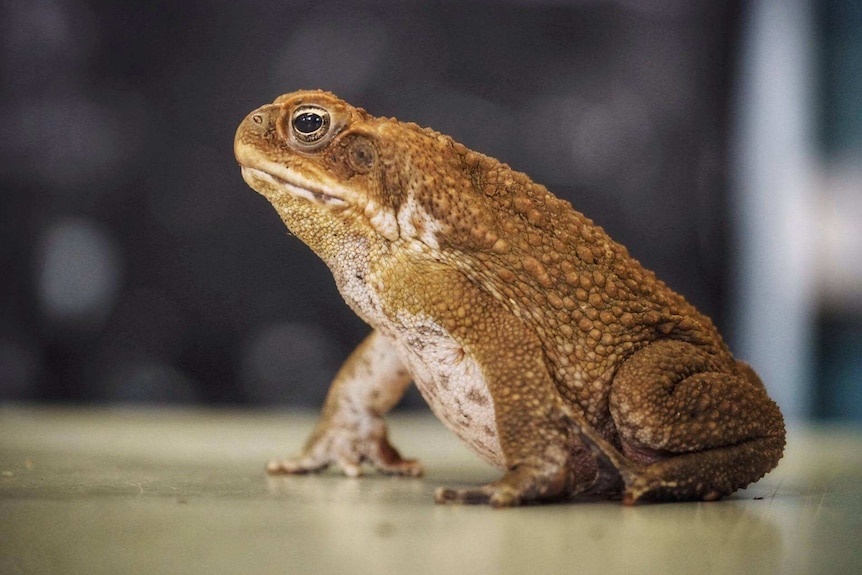by Elsie Adamo and Selina Green
ABC Rural

Hitchhiking cane toads have been spotted in regional areas as well as major cities. (ABC News: Mitchell Denman Woolnough)
In short:
A cane toad recently hitchhiked into Adelaide and was spotted in a city park.
While not traditionally suited to a southern climate, climate change could contribute to populations establishing in new areas.
ABC Rural
Hitchhiking cane toads have been spotted in regional areas as well as major cities. (ABC News: Mitchell Denman Woolnough)
In short:
A cane toad recently hitchhiked into Adelaide and was spotted in a city park.
While not traditionally suited to a southern climate, climate change could contribute to populations establishing in new areas.
What's next?
Work is being done to help prepare for any future outbreaks.
Southerners are being asked to keep an eye out for hitchhiking cane toads before they get a chance to establish new populations.
The call comes after a cane toad was captured last week near a university campus in the centre of Adelaide.
The invasive species is unfortunately a common sight further north in Queensland but not so common in southern Australia.
So how do cane toads end up in Adelaide? They hitch a ride.
Spotting a toad down south
South Australian Department of Primary Industries and Regions senior biosecurity officer Kate Fielder said about 40 cane toad sightings were reported in the state each year.
Cane toads have been transported across the country in trucks, cars and even luggage. (Supplied: Cathy Zwick)
Of those, two to three are found to be real cane toads.
"Most of the time they are cane toads that have hitched a ride from interstate or overseas," Ms Fielder said.
"Thankfully we do have a lot of vigilant members of the public here and they are always keeping an eye out.
"We know cane toads are one of the worst pests in Australia and we certainly don't want them to get here."
Preparing for an outbreak
Even though there are no established cane toad populations in South Australia, work is being done to prepare for any potential incursions or outbreaks which may occur in the future.
"We've got traps which draw in cane toads using vocalisation," Ms Fielder said.
"And we are looking to get into the use of AI [artificial intelligence] to detect cane toads vocalisation in the wild.
"So a little monitor will sit out in the wild and alert us if it hears a cane toad."
Cane toads were introduced into Australia in the 1930s. (ABC Kimberley: Ted O'Connor)
Invasive Species Council conservation and biosecurity analyst, Lyall Grieve, said he was not surprised cane toads were found in South Australia.
"They're extremely good at hitchhiking," he said.
"It only takes a few of them to start a population."
While the species did not naturally do well in the South Australian climate, he said they were still a threat.
The 'waterless barrier' that could stop cane toads invading the Pilbara
Photo shows A cane toad on a rock lit by a flash, in the background a pink sky and a boab tree silhouette
A bevy of small mammals and lizards could find themselves on the endangered species list if cane toads got into the Pilbara. A bold plan could prevent the biodiversity disaster.
"With climate change we're getting some warmer winters, we're getting warmer temperatures, we're getting extreme weather events like flooding," Mr Grieve said.
"All of those things will lead to a situation where cane toads could actually establish further south."
He said while the risk of established populations in South Australia was not immediate, one female could lay two clutches of up to 35,000 eggs a year so no chances could be taken.
"We don't want people to be to be worried or to be afraid that they're suddenly going to be overwhelmed by cane toads," Mr Grieve said.
"They're very good survivors, they're very good at rapidly filling an environment and over competing all the native frogs and reptiles.
"It really wouldn't take long, maybe a couple of years to establish a reproducing population."
Identifying cane toads
Anyone who believes they have spotted a cane toad should contact the Australian Pest Alert Hotline and not attempt to kill any the animal themselves.
Cane toads were introduced to control pest beetles in Queensland's sugar cane crops. (ABC News: Alex Hyman)
"In other parts of Australia there's been a lot of sad cases of misidentification," Mr Grieve said.
"Well-meaning people think they're found a terrible pest … unfortunately there's a lot of native frogs that do look a bit similar."
No comments:
Post a Comment